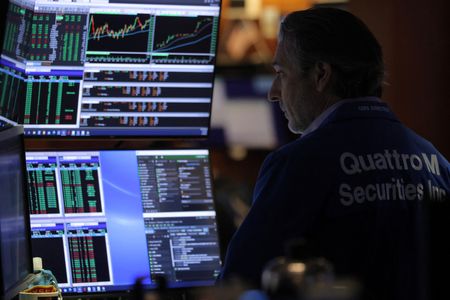
By Amruta Khandekar and Devik Jain
(Reuters) – The benchmark S&P 500 index is trading down 20% from its Jan. 3 record close in volatile trading on Friday, as investors fretted over the impact of rising inflation on earnings and the fallout of interest rate hikes on economic growth.
A close of 20% or more below that level will confirm the S&P 500 is in a bear market for the first time since the 2020 Wall Street plunge brought on by the coronavirus pandemic.
The tech-heavy Nasdaq is already in a bear market, down 30.7% from its record close in November 2021.
Ten of the 11 major S&P sectors declined, with consumer discretionary and industrials down 3.5% and 2.2%, respectively.
Apple Inc, Google-owner Alphabet Inc, Nvidia Corp and Tesla slid between 2.5% and 9.9%, weighing the most on the S&P 500 and the Nasdaq. Both the indexes had climbed above 1% in morning trading.
Shares of Deere & Co tumbled 12.1% and were the biggest drag on the industrial sector after the heavy equipment maker posted downbeat quarterly revenue.
“In this process of a bear market, it is very common to have these intraday swings and counter cyclical rallies in it,” said Will Nasgovitz, chief executive officer at Heartland Advisors.
“We are going to probably see a bear market (in S&P 500). The market is reflecting that the economy is not standing extremely tall, there are some cracks in the foundation.”
Disappointing forecasts from big retailers Walmart Inc and Target Inc rattled market sentiment this week, adding to evidence that rising prices have started to hurt the purchasing power of U.S. consumers.
The S&P 500 and the Nasdaq are set for their seventh straight week of losses, their longest losing streak since the end of the dotcom bubble in 2001.
The Dow is on track for its eighth consecutive weekly decline, its longest since 1932 during the Great Depression.
The three major indexes are down between 15.1% and 28.6% so far this year as investors adjust to supply-chain snarls, lockdowns in China, geopolitical uncertainty stemming from the Ukraine conflict and the U.S. Federal Reserve raising rates.
Traders are pricing in 50-basis point rate hikes by the U.S. central bank in June and July.
At 12:54 p.m. ET, the Dow Jones Industrial Average was down 439.27 points, or 1.41%, at 30,813.86, the S&P 500 was down 69.83 points, or 1.79%, at 3,830.96, and the Nasdaq Composite was down 291.39 points, or 2.56%, at 11,097.11.
Expiration of monthly options contracts on Friday was likely to boost trading volumes and could also add to volatility, especially toward the end of the session.
Ross Stores plunged 23.8% after the discount apparel retailer cut its 2022 forecasts for sales and profit, while Vans brand owner VF Corp gained 3% on strong 2023 revenue outlook.
Declining issues outnumbered advancers for a 2.84-to-1 ratio on the NYSE and for a 2.85-to-1 ratio on the Nasdaq.
The S&P index recorded one new 52-week high and 47 new lows, while the Nasdaq recorded 10 new highs and 285 new lows.
(Reporting by Amruta Khandekar and Devik Jain in Bengaluru; Editing by Shounak Dasgupta and Arun Koyyur)

